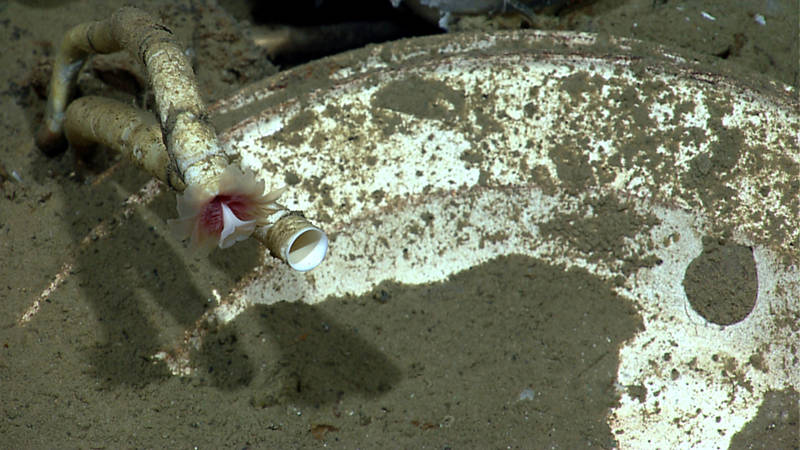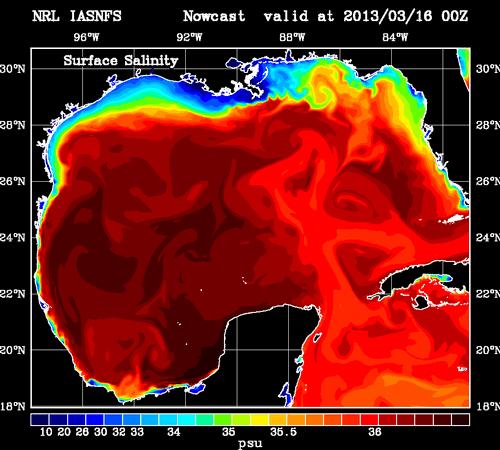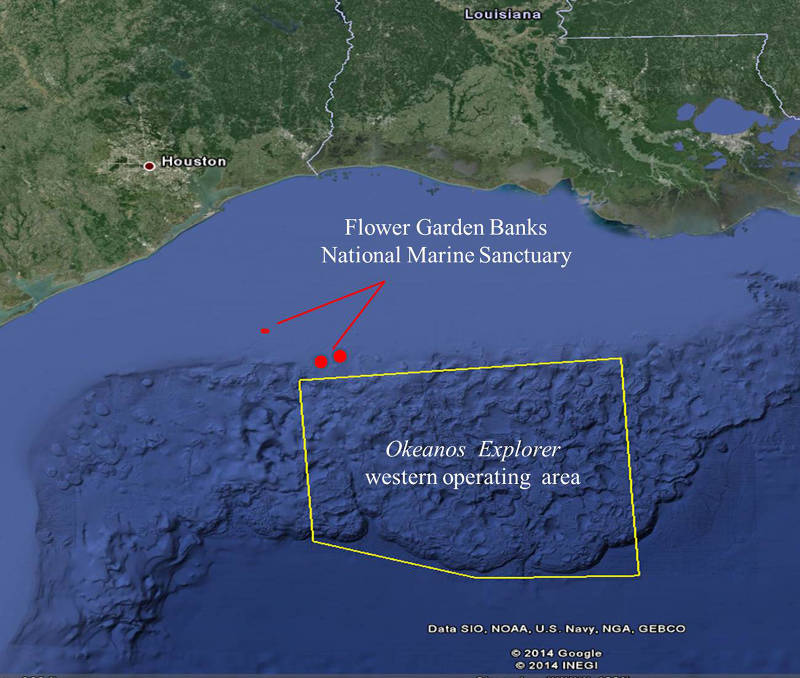
By Dr. Steve Gittings, NOAA Office of National Marine Sanctuaries
Dr. Bill Kiene, NOAA Office of National Marine Sanctuaries

During the 2012 Northern Gulf of Mexico Expedition, NOAA Ship Okeanos Explorer found tube worms at one of the Monterrey Shipwrecks. These worms are more commonly associated with methane seeps in the Gulf of Mexico. Living in the dark, deep sea, they derive their sustenance from bacteria that use chemosynthesis instead of photosynthesis, which is only possible in the sunlit upper ocean. These discoveries by Okeanos Explorer help to piece together the puzzle of how life adapts to unique conditions on the seafloor and moves between different biological habitats across the vastness of the deep Gulf of Mexico. Image courtesy of NOAA Office of Ocean Exploration and Research, 2012 Gulf of Mexico Expedition. Download larger version (jpg, 1.4 MB).
We usually think of the deep ocean as being so isolated and enormous that our lives are of little consequence to it. Most deep-ocean places are far from land, buffered by distance and a thick layer of water, and seldom, if ever, see human visitors.

Corals and anemones colonize a rocky outcrop in the deep Gulf of Mexico. Brittle stars find a home on the coral. When life establishes on a new outcrop, from where do the species come, how do they find their homes in the vast dark abyss, and where do their offspring go? These are a few of the many questions we hope data from the expedition will provide insight on. Image courtesy of NOAA Office of Ocean Exploration and Research, 2012 Gulf of Mexico Expedition. Download image (jpg, 128 KB).
We’ve all seen fantastic images of spectacular oases of life in the deep sea – giant tubeworms, mussels, and shrimp around hydrothermal vents; canyons lined with delicate sponges and corals; and secluded deep coral reefs. These areas are bursting with life, but are few and far between if you consider the vastness of the ocean itself.
We often think of these places as isolated from one another. So focused are we on the strangeness of these places that we may not give a second thought to how animals move across the vast, cold, dark depths to get from one oasis to another. We don’t consider the connections between places nearly as much as we think about the mystique of the individual places themselves.

This is an animation of the real-time currents in the Gulf of Mexico. The map shows sea surface salinity, which can be used to show current patterns in the Gulf. Animation courtesy of the Naval Research Laboratory Ocean Dynamics and Prediction Branch. Download image (gif, 2.0 MB).
To fully appreciate the workings of life in the deep ocean, knowing ecological connections is key.
For example, in shallow water, coral reef fish often release eggs in one area only to see them drift off for a month before they hatch, their offspring ending up in a distant location. Are similar reproductive strategies used in the deep sea? What happens to the larvae of clams around hydrothermal vents? Do they stay close to home or drift off to colonize other vents? We know that at least some travel, because newly formed vents do become colonized, but how do animals find these sites and how important are the exchanges between vent communities?
In April 2014, NOAA Ship Okeanos Explorer will visit a variety of Gulf of Mexico habitats, looking for clues to connectivity across the 1000-mile wide basin – from the coral habitats of the Florida Escarpment to the brine pools and canyons on the northwestern Gulf’s continental slope. We’ll even explore life on 200-year-old shipwrecks that rest on the seafloor nearly a mile below the surface.
How does life on these wrecks compare to that on natural seabed features? What do similarities and differences in different habitats tell us about how water or wildlife move between them, and how connected they are to the better-known shallow areas of the Gulf of Mexico? Can exploration of these habitats also tell us how vulnerable deep Gulf ecosystems are to destructive human activities – whether they are likely to recover from damage, and if not, what protections we can put in place to avoid it?

During the 2014 Gulf of Mexico Expedition, NOAA Ship Okeanos Explorer will explore an area adjacent to the Flower Garden Banks National Marine Sanctuary. Using the Deep Discoverer remotely operating vehicle, the team plans to visit a variety of habitats, gathering data that will help scientists investigate connectivity across the Gulf of Mexico. Image courtesy of NOAA Office of Ocean Exploration and Research. Download larger version (jpg, 447 KB).
As scientists supporting management of our national marine sanctuaries, why do we care about these remote, deep places?
For one, it’s very clear that the deep sea is, in fact, not at all isolated from humans. The shipwrecks we will explore, the lost fishing nets we may encounter, and the deep-water infrastructure of the extensive oil and gas industry in the Gulf are all evidence of the past and present human footprint, and represent newly created deep-ocean habitats.
How these habitats affect surrounding native ecosystems is unknown. Perhaps they help some species move from place to place. But might they also be stepping stones for threats that could harm the ecosystems, perhaps even some within our marine sanctuaries?
All these questions beg for a better understanding of connectivity in the deep sea. Join us as we explore the wonders of the deep Gulf of Mexico and see why this place is so special.